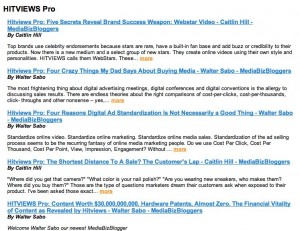Grant Crowell, one of our favoritest writers at our favoritest websites (ReelSEO), tackled the subject of online-video webstars and their sponsored videos. He interviewed Hitviews‘ Sam Levine. Check it out…
Tag Archives: webstars
ABC News Features YouTube Stars (and Income Accuracy)
Two out of three YouTube stars (Jody Rivera/VenetianPrincess and Greg Benson/Mediocrefims) featured in ABC News’ story on “YouTube Top Earners” were among the dozen profiled in my “Beyond Viral” book.
Coincidence? Or did the student author, Clay LePard (a member of the ABC News on Campus bureau at Syracuse University) forget to read his journalism manual on source citation? Hey it got Greg and Jody some press, as well as Ryan “Nigahiga” Higa. So it’s all good.
Now onto the estimates by Tubemogul (see Business Week)… while being directionally accurate and based on decent assumptions, they are often quite wrong… according fellow YouTube creators with whom I’ve spoken. Of course we’re all obliged by contract to keep the numbers to ourselves. I do know that the income estimates by Tubemogul for some individuals (who have fewer views than I) are paradoxically higher than my own actual income. It’s also worth noting that those Tubemogul estimates don’t include the more lucrative but sporadic sponsored videos.
The reality is that it’s total conjecture since even with total view counts, the actual income per video can range radically depending on the advertiser bidding. What’s important is that a) some do make enough to live comfortably, b) nobody knows how long it will last, c) it’s extremely difficult odds to live on YouTube income.
And as I like to remind people… if I calculated the time I’ve spent on YouTube and arrived at an hourly salary, I’m quite sure that I’d beat it working at Taco Bell. But I enjoy it, so I don’t bother with the math. At least the blog is profitable. Oh wait- that’s right. It’s got no revenue stream. Well ya get what you pay for.
Online-Video to Marketers: Lighten Up, Francis!
In one of the more memorable moments of the incredibly quotable Stripes, a new recruit warns his fellow troupe: “The name’s Francis Sawyer… but everybody calls me psycho… any of you call me Francis I’ll kill you.” The drill sergeant’s response: “lighten up, Francis” (see video).
“Lighten up” was one of the pieces of advice in a column titled, “Four Ways to Protect Your Brand: Throw Away The Script.” The piece, written by former show-business executive Walter Sabo, reflects his learnings as CEO of Hitviews, a company that helps brands leverage online-video stars to produce sponsored videos that reach viewers in a different way than most online advertising.
It’s hard for a marketer to let go of his or her message, especially when the more a marketer cares about a brand the harder it is to see a promotion depart from a well-researched and carefully crafted strategy, message map, and creative brief.
I’d argue that “letting go” or “lightening up” is the second most difficult thing to do (followed almost certainly by gaining approval to engage in non-formatted promotion from conservative legal council and senior management less familiar with the medium). On this blog I’ve recounted my own experience with “giving up control” on social media. I preached it while at J&J but it became a lot more difficult when I saw my own brand (Propecia and “Nalts”) take on their own personalities online. In some cases both Propecia and “Nalts” (if I may call my online persona a brand) was inaccurate or at least incomplete. Fortunately Walter is not asking brands to depart from strategy, but to allow more creative control than we marketers typically afford agencies.
Indeed a video star is different from an agency’s director or producer. They have their own voice, and an audience that expects that voice to carry through entertainment and the occasional promotion. Have you ever heard a spot by Howard Stern? Give him too much copy or edit his script departures and you lose the impact of having him endorse the product — which sounds like an endorsement by a trusted personality.
I’m not familiar with many marketers who will enjoy being told to “lighten up,” but I trust that agencies can help educate their clients that a carefully controlled promotion is called an “advertisement” and is quite often tuned out. But webstars given some creative freedom to make the message their own is what breaks through the clutter.
Disclaimer: I am a “webstar” who has made videos for Hitviews on behalf of such clients as Reader’s Digest, Fox, MTV and Microsoft. One of my favorite aspects of this medium is trying to make widely-viewed videos that promote a brand but, above all, entertain. In most cases when a brand tampers in the creative, the views and persuasive power of the video is not as high. That doesn’t mean we “webstars” don’t need strategic direction and a creative brief… it just means that if we’re allowed to interpret it in our style for our audience the results are far more interesting.
Why Online Video is More Like Radio than Television
 Walter Sabo, Hitviews founder and former radio maven, makes it more apparent why radio people seem to have adapted more naturally to online video than television people. At first I thought it was simply that the radio people saw their boat sinking sooner than television people (some who vary their whistling melodies and choose a new route past the graveyard to show they’re flexible).
Walter Sabo, Hitviews founder and former radio maven, makes it more apparent why radio people seem to have adapted more naturally to online video than television people. At first I thought it was simply that the radio people saw their boat sinking sooner than television people (some who vary their whistling melodies and choose a new route past the graveyard to show they’re flexible).
In fact there’s another reason that Sabo has attracted radio investments and a posse of former radio sales people, and it’s evident in his anti-standard piece and even more succinctly in his “Four Crazy Things My Dad Said About Media Buying”:
Every radio spot he (Sabo’s father and store owner) bought was a live read by personalities. Every print ad was endorsed by a local celebrity. Every TV buy at least had live tags even though TV was too precious to offer live spokespeople. On the Internet he would have bought a webstar video visiting the business and talking about it. We all buy products from friends.
Indeed radio and today’s version of online video are arguably more alike than online video and television. Why? The talent carries the show. You may like the tunes best, but you can’t argue with the facts: when a radio star jumps stations, the audience often follows. Is it any coincidence that one of YouTube’s hottest properties is a former disc jockey (yeah the fat guy- Shaycarl). If Shay loved beets I’d eat ’em.
Online video is about a charismatic human and people who enjoy them… unscripted reality and a fairly intimate relationship (as one-to-many goes). Like radio personalities, online video folks don’t mind plugging a good sponsor. And that doesn’t work as naturally on the boob tube, except for during an occasional talk show (where’d that format come from again) or that radio-like television show we call American Idol.
I’m not entirely unbiased about Sabo’s poetry (see below graphic to find the “Hitviews Pro” series on JackMyers.com) because I have a working relationship and friendship with the radio and online-video media maven… Still, I do believe he’s the Billy May’s of online video. He cuts through a lot of the jargon and states inarguable truisms, and it’s especially charming when he quotes his dad. Get on his good side, and he’ll give you a bear hug, make you feel special, and drive two states to bring you cookies when you’re having back surgery. Get on his bad side, and he’ll pinch your brain. Either way you’ll find him more interesting than the average human, and check your pulse if you don’t find this article about why records in automobiles failed (it’s not why you’d think).
Since my blog’s been a bit slow lately, here are 5 great articles by Walter “Regis” Sabo and Caitlin “Cathy Lee” Hill. Perhaps the most fascinating aspect of Sabo is his blatant disregard for middlemen, especially media buyers. (Just once I want a media buyer to tell me how prejudice I am, and prove me wrong).
“Viral Video is Dead” Echos in Canada & Beyond
If there’s one thing more fun than speaking to hundreds of marketers before a giant video of yourself like a “Rolling Stones” concert, it’s to read Twitter “tweets” after you speak.
By searching #mweek and @nalts after my talk on Wednesday, I learned what “stuck” with the Toronto “Canadian Marketing Association” audience. Canadians are nice, and apparently quite addicted to Twitter. They surprised me by almost making me sound intelligent in the quotes they shared.
Here are two of the things people most RT’d (aka retweeted, which here means posting on Twitter or sharing someone else’s Twitter post).
- Viral is dead.
- An impression isn’t an impression unless it makes one (see TechVibes coverage).
Marketing Magazine led with this article titled “Marketing Week Begins with ‘Viral is Dead’ Declaration.” IT Business was struck that a “viral is dead” statement woud come from “a person who owes his fame and fortune to tons of viewers on YouTube.” Then there’s the Canadian Star, which captured one of the most important points I hoped to make:
But advertisers don’t have to spend millions making YouTube videos, like the Evian Roller Babies, in hopes they go viral, Nalty said. The ad features digitally animated babies rollerskating to rock music. Instead, they can use existing YouTube stars, like Fred Figglehorn, the teenager with the annoying high-pitched voice and the online following bigger than Oprah’s TV audience, Nalty said. Fred makes a six-figure income from advertisers on his YouTube posts, Nalty said.
Certainly there’s a robust future of incredible clips that will gain “viral” fame. But my point was that marketers should not waste time and money investing in clips with hope that they go “viral.” It’s rare for a commercial clip to be shared wildly, although Evian’s babies is a recent exception.
Instead, I encourage marketers to chose the more efficient and guaranteed approach of partnering with online-video weblebrities. These individuals have large, recurring audiences and fans. So their sponsored videos are far more likely to travel the web and be seen by millions. I showed the Hitviews case study on Fox Broadcasting as proof. Two of my Fox videos alone have surpassed 1 million views each, which was half the targeted views of the campaign (for “Fringe” and “Lie to Me”).
I was encouraged to speak with a number of creative directors (or former creator directors) that seemed excited about the prospects. I had feared that they’d feel threatened by an online-video “weblebrity” creating videos that aren’t as easy to control. But they seemed to appreciate the idea of giving a popular creator a creative brief, and some room to tailor the message to his/her audience and style.
Here’s the deck, though most won’t make sense without context. Steal away. Spread the word.
But remember two things above all. US/Canada border guards require passports, and don’t care to be videotaped even if it’s on a Hello Kitty Flipcam. Trust me on those.



